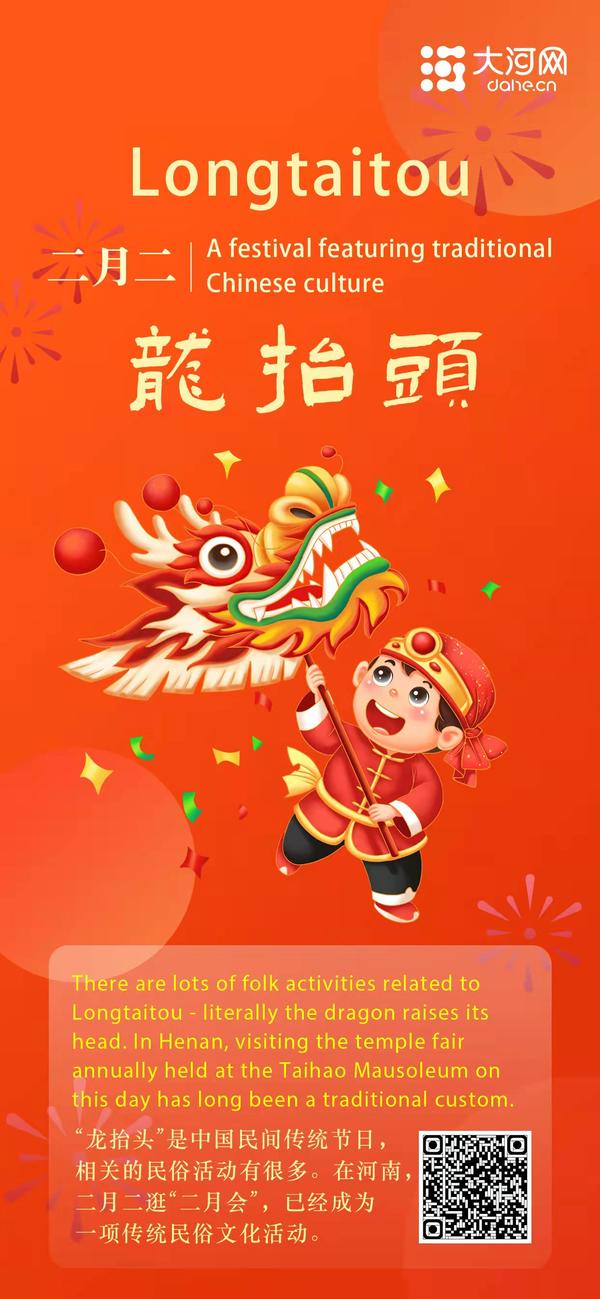Longtaitou, a Festival Featuring Traditional Chinese Culture
As the Chinese old saying goes: "One of Chinese festivals, Longtaitou, which falls on the second day of the second month of a year, comes with the busy spring-ploughing season."
俗话说:“二月二,龙抬头,大家小户使耕牛。”
Click on the video
Longtaitou - literally the dragon raises its head - is a festival featuring traditional Chinese culture. Also known as the Dragon Head-raising Festival, it falls annually on the second day of the second month on the Chinese lunar calendar. Since this day, with the rise of temperature and increase of rainfall increase, spring ploughing begins.
“龙抬头”,是中国民间传统节日,又称春耕节、农事节、青龙节等。在农耕文化中,“龙抬头”标示着阳气生发,雨水增多,万物生机盎然,春耕由此开始。
There are lots of folk activities related to Longtaitou, which are different across China. In Central China’s Henan province, visiting the temple fair at the Taihao Masoleum on this day has long been a traditional custom.
与“龙抬头”相关的民俗活动有很多,但地域不同,风俗也有一定差异。在河南,逛太昊陵庙会,早已成为一项传统民俗文化活动。

Taihao Mausoleum. [Photo provided to dahe.cn]
Taihao Mausoleum, located in Huaiyang district of Henan's Zhoukou city, is believed to be the mausoleum of Fuxi, a legendary figure said to be one of the earliest ancestors of the Chinese. For thousands of years, it has become a holy land for Chinese people at home and abroad to seek their roots and pay tribute to their ancestors. In particular, the temple fair held annually at the mausoleum from the second day of the second month to the third day of the third month on the Chinese lunar calendar is a traditional Chinese folk activity integrating ancestor worship, performance, leisure and commerce.
位于周口市淮阳区的太昊伏羲陵,相传是伏羲氏的长眠之地。千百年来,这里成为海内外华夏子孙寻根谒祖、旅游观光的圣地,特别是每年农历二月二至三月三的朝祖庙会,更是集祭祀、歌舞、文娱、商贸于一体的中国传统民俗活动。
The temple fair held annually at the mausoleum, also known as the "February Temple Fair" locally, is praised as China's largest temple fair featuring the longest period and the largest number of tourists, conveying people's good wishes of dispelling evils and avoiding disasters. Clay dogs and cloth tigers sold at the temple fair are dubbed as the living totems and fossils. Over 100 folk performances staged during the temple fair demonstrate the charm of traditional Chinese culture, attracting many tourists at home and abroad.
太昊陵庙会,又称“二月会”,被誉为中国规模最大、历时最长、参会人数最多的庙会,寄托着劳动人民祛邪、避灾、祈福的美好愿望。庙会上出售的“泥泥狗”、“布老虎”等手工艺品,被国内外专家学者誉为“真图腾”、“活化石”,而庙会期间举办的百余种民俗展演活动,更是展示了中国传统文化的特质和魅力,吸引着国内外众多游客的目光。

Taihao Mausoleum. [Photo provided to dahe.cn]
The ceremony whoshipping Fuxi is one of the first national intangible cultural heritage projects in China. It is worth noting that around 825,600 tourists visited the temple fair on March 22, 2008 (the fifteenth day of the second lunar month). Owing to the largest number of tourists per day, it was included in the Guinness World Records by the Shanghai-based Great World Guinness Headquarters, thus enjoying a reputation of the “No.1 Temple Fair in China”.
据了解,淮阳“太昊伏羲祭典”是首批国家级非物质文化遗产项目。2008年3月22日(农历二月十五),参与庙会人数高达825600人,被上海大世界基尼斯总部列入吉尼斯世界纪录,有“天下第一庙会”的美誉。(文案/赵汉青 播音/王家琦 制作/王君艺 审核/李文竞)

